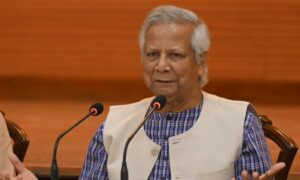
Mythology has rarely been kind to women. Across cultures and geographies, it has replicated patterns of patriarchal oppression by trapping women in an inviolable binary of sacrificing mother/wife and evil temptress/hag. Epics centre on the valour of men and the submission of women. Helen is both a trigger and a trophy of war. Her sister, Clytemnestra, has been condemned to literary villainy for the brutal murder of her husband, Agamemnon. Cassandra makes prophecies that no one believes. Medea kills her children to punish her husband.
Closer home, Sita follows her husband into exile, is abducted, fought for, and subsequently abandoned. Surpanakha is punished for her desire and has her face mutilated. Panchali is given in marriage to five brothers. Woman after woman is denied agency in stories told by men. Venerated for her virtue or brutalised for her transgressions, the woman of mythology has been silenced for far too long. At a time when mythology, especially in this country, is being wilfully misread as history, the task of course correction seems to have fallen to the writer of fiction. While Natalie Haynes, Madeline Miller and Pat Barker have re-viewed the Greek tradition, writers like Samhita Arni, Amruta Patil, Chitra Banerjee Divakaruni, and Vaishnavi Patel have returned to the Indian epics, liberating the voices of the women of the Ramayana and the Mahabharata, one narrative at a time.
A different Sabari
Writer-translator-poet Volga’s On the Banks of the Pampa, translated from the Telugu by Purnima Tammireddy, has the same project. It tells the story of Sabari, an ascetic living in the ashram of Maharshi Matanga, on the banks of the river Pampa. An aranyavasi, deeply integrated within the life of the forest, Sabari waits eagerly to meet Ramachandra, the prince from the north who was sent into exile by his stepmother, now on a journey to rescue his abducted wife. A far cry from the uncritical devotee of the Valmiki Ramayana, Volga’s Sabari is a woman who has led a rich, complex life of her own, has found knowledge outside of dogmatic discourse, and who hopes to find a resonance of her ideas of humanity, wisdom, and harmony in Ramachandra. Marking a significant departure from received, popular, televised renditions of Sabari as the simpleton who offered Rama berries she had tasted for sweetness, the woman who, like countless others, Rama set free of the cycle of re-birth and sent onward to moksha, Volga’s Sabari is a formidable intellect. Rebel, runaway, survivor, Sabari flips the narrative of the woman who waits for absolution, becoming, instead, the one who offers it.
Two of Volga’s earlier novels have dealt with similar themes. The Liberation of Sita (2016) brings together five stories of women relegated to the margins in the Ramayana. Yashodhara (2019) reconstructs the life and choices of the woman known to the world only as the abandoned wife of Gautama Buddha, who slept as her husband walked out of his home in search of enlightenment. Volga’s Yashodhara is as much of a thinker as her husband, Siddhartha Gautama; his equal in philosophical and intellectual enquiry. Sita, a forest-dweller like Sabari, is at the centre of a sisterhood that rises against the universality of gender-based violence and oppression. The three texts work like a triptych, if not a trilogy, exploring the same complexities of a patriarchal world order that attempts to divest women of power and selfhood. Sita, Yashodhara, and Sabari share an interesting set of characteristics. All three have rejected convention, faced social censure, and stood firm in their convictions. They are pacifists in a world that thrives on the pursuit of power and the acquisition of land and all that lives on it. Volga’s women characters, whether at the centre of the story or on its periphery, are all expositions of her feminist politics – an assertion of female agency, in close alignment with a rejection of the Anthropocene.
On the Banks of the Pampa situates itself within two conflicts. The forest and the city stand in stark opposition to each other. The novel opens with a prefatory scene of tranquillity, in a forest where all life – animal, human, plant, geological – exists in harmonious balance. There are no gender prejudices in this world. Children are celebrated by the community. Death is but a part of the cycle of life. “There were fewer tragedies in the lives of those living in the forest”, the reader is told. The peaceful existence of the aranyavasis is threatened by “civilisation” or nagarikta, the way of life of the city-dwellers, the citizens of the rajyam. The rajyam is an imperial force that has invaded forests, islands, and hills, “inflicted pain and terror on earth, compelling it to produce beyond its capacity.” Sabari herself has been a victim of the atrocities and the excesses of the rajyam. Forced to go to the city in search of her grandfather when she was ten years old, her family is held captive and Sabari is isolated from her parents and sent to a camp for the children of detained migrants. The treatment of those deemed illegal and the ferocity with which borders are drawn and guarded by a hostile administrative structure are chillingly familiar. Volga’s version of the rajyam is a critique of modern-day colonisation, where land and resources belonging to those who have nurtured them are taken away in the name of development and the promise of “special rights” is made, like a concession.
A voice of dissent
A corollary of the same is the conflict between jnanam and ajnaman in the novel, one held in the sacred custody of Brahmin scholars and gurus, and the other, the domain of those who live in close association with their ecological environment, resplendent and blissful in their ignorance of hegemonic knowledge. Jnanam is a divisive, oppressive force that engenders greed and keeps the already powerful engaged in the task of endless acquisition. Ramachandra’s quest is for greatness. He desires to further the cause of the Aryas by ridding the forests of all demons and conquering more and more land. He wishes to be remembered as “the maryada purushottam, the best among honourable men” and believes that the only way to fulfil his destiny is by adhering to the rules of dharma and nagarikta. Jnanam is also the facilitator of caste oppression. Maharshi Matanga, Sabari’s guru, has been set on a path of penance by his preceptor to atone for the sin of his low caste birth. It takes a lifetime of experience and a final immersion into ajnanam for the maharshi to realise the inhumanity of the caste system. Jnanam is what compels Hanuma and Sugreeva to avenge themselves on Vali for the dishonour inflicted on them; instead of living peacefully on the mountain they have found refuge in. For Sabari, jnanam is the ultimate hegemonic structure, sanctioning the inequities of gender, caste, and race.
Purnima Tammireddy refers to Volga’s trilogy as “retellings of myth-history”. T Vijay Kumar and C Vijayasree, the translators of The Liberation of Sita, see her writing as a “compelling exercise in ‘re-visionist myth-making’.” Either way, the emphasis is obvious. These stories challenge our reception of mythology. Crucially, they signal the fictionality, the malleability of mythology, not allowing the reader to settle into comforting certainties. Their politics are unabashedly loud. On the Banks of the Pampa is an ecofeminist text that takes the four shlokas about Sabari in the Valmiki Ramayana and turns them into a celebration of a woman’s dedication not to a saviour, but to an ideology that intended to heal a world debilitated by state-sanctioned misogyny, violence, and caste prejudice. Volga’s Sabari is a voice of dissent, a woman who has survived the brutality of the state, becoming the flagbearer of radical subversion. Volga champions the outliers – migrants, tribals, outcasts, pacifists. Subtly, she breaks down the compulsions of patriarchal control, questioning the heroism of self-aggrandising men, freeing women from the cloying paradigms of victimhood. This narrative of Sabari, emerging as it does at a time when the extreme right is insistent on women regressing into socially sanctioned submissive roles, when feminism has been deemed a problem, and when the myth of “development” has turned into an opiate for the masses, is a much-needed wake-up call, if one would only care to listen.
On the Banks of the Pampa, Volga, translated from the Telugu by Purnima Tammireddy, HarperCollins India.
📰 Crime Today News is proudly sponsored by DRYFRUIT & CO – A Brand by eFabby Global LLC
Design & Developed by Yes Mom Hosting






